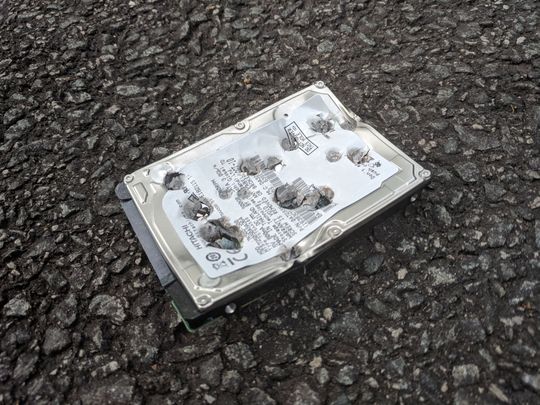In this enlightening conversation on Vida Digital, Alex Neuman speaks with Angela Keary of DriveSavers Data Recovery about the human stories behind lost data—from families desperate to recover irreplaceable memories to companies fighting ransomware attacks.
USA Today: Even a Dead Hard Drive Can Give Away Your Private Info. Here’s How to Delete it for Good

Photo:Intel
Originally published by USA Today.
Reminder: Your data can survive on a dead hard drive.
A hard drive crash is unnerving enough by itself — the tiny bundle of electronics that warehoused your data for years suddenly stops working, often with no warning. But when that drive is a backup volume that held your most sensitive data, you have an extra worry: That it’s not dead enough, meaning your information can be retrieved with specialized tools.
“This is a typical scenario that we see from hard drives,” emailed Mike Cobb, director of engineering at data-recovery firm DriveSavers. He added that his Novato, Calif., employer “wouldn’t be in business if we couldn’t recover from this scenario.”
But what if you don’t want to recover it — but make sure that information vanishes after you place it in the electronics waste recycling?
You could keep the dead hard drive at home until the value of the data on it has decayed. But it’s faster and more practical to destroy the drive.
How do that, however, is not something on which experts agree. At one extreme, you can pay a drive-shredding firm to use specialized machinery to rip a drive into tiny bits. These services rarely post prices (one, Oakville, Ontario-based Shred-It, wouldn’t even answer a request for a range of rates), but I’ve yet to see users report a price below $10 a drive.
By way of comparison, Cobb said DriveSavers charge from “several hundred dollars” up to thousands to recover a drive, with the difference due to the degree of damage and how fast a client needs the data back.
Cobb advised paying up for professional drive destruction. But Cooper Quintin, senior staff technologist at the Electronic Frontier Foundation, said a DIY approach suffices for people whose threat model doesn’t include any foreign government’s spy services.
“It’s not that hard to destroy a drive,” he said, advising that the important thing is to smash not just the electronics around the drive but the magnetic platters inside.

“Drill all the way through it, smash it with a hammer, render it totally inoperable,” Quintin said. “I recommend doing this outside since it’s messy work.”
Since I did, in fact, have a backup drive die last month, I decided to test his advice by taking the deceased volume out to the driveway and stabbing it with the pointy end of a crowbar. After a minute or two of easy but satisfying work, the drive looked as if it had died in a hail of bullets, with a dozen holes punched through it.
Per Quintin’s warning, the pavement around the mangled drive was flecked with small bits of drive platter mixed with finer particles of destroyed circuitry — a sort of cybernetic sand that I had to sweep up.
If you keep your backup drive encrypted, however, you can sidestep this worry entirely. Without the encryption password, any would-be data thief would see only gibberish.
Apple’s Time Machine software includes that option, although enabling it will require redoing your backups from scratch.
Microsoft does not include a comparable feature in the home version of Windows 10’s backups tools; you can employ the free, open-source VeraCrypt to encrypt a backup drive, but Microsoft should realize that drive security isn’t something that only business users want.





